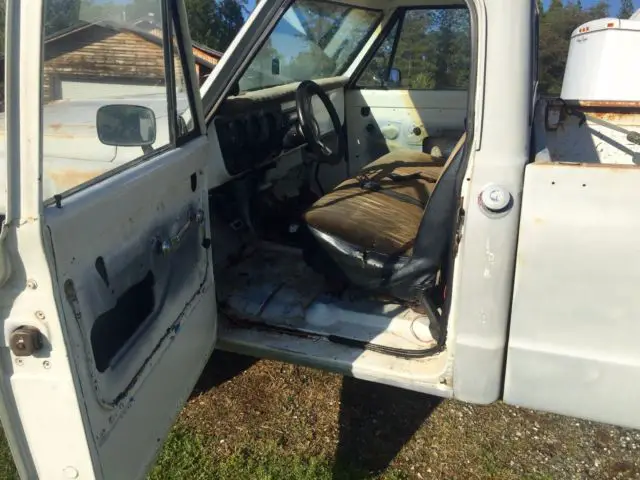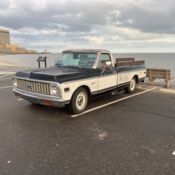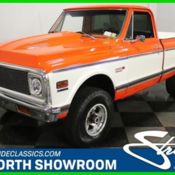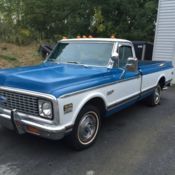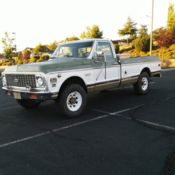1972 Chevrolet K-20 Cheyenne 4x4 Pickup - Original 4x4 -Super Rare!!
| Condition: | Used |
| Make: | Chevrolet |
| Model: | Other Pickups |
| SubModel: | K-20 Deluxe 4x4 Super Clean Example Rare Find |
| Type: | Standard Cab Pickup |
| Trim: | CHEYENNE DELUXE |
| Year: | 1972 |
| Mileage: | 99,999 |
| VIN: | CKE242Z170077 |
| Color: | White |
| Engine: | 350 V8 |
| Cylinders: | 8 |
| Fuel: | Gasoline |
| Transmission: | Automatic |
| Drive type: | 4WD |
| Interior color: | Black |
| Vehicle Title: | Clear |
| Item location: | Grass Valley, California, United States |
| Extras |
|
4-Wheel Drive |
| Listed by | Private seller |
Description of 1972 Chevrolet Other Pickups K-20 Deluxe 4x4 Super Clean Example Rare Find |
|
72’ Chevy Custom K-20 Cheyenne Deluxe 4x4 Pickup 4" LIFT 33" TIRES ON 16" BLACK STEEL WHEELS HIGH PERFORMANCE LONG TUBE HEADERS TO TRUE DUAL FLOMASTER EXHAUST DANA 44 FRONT AXLE WITH Power Steering & Power DISC Brakes Original 4 Wheel Drive Electric Fan and Custom Bumpers THE 1972 CHEVY K20 CHEYENNE DETAILS Vehicle:’72 Chevrolet K20 Cheyenne Super Transmission:TH350 automaticw/ B&M Holeshot Shifter Transfer case:NP205 This Truck Is Sold As IS. I Purchased this Truck to Do a Full Restoration, However Due to Severe Injury, I am Unable to Perform the work myself. The Truck Runs, Drives and Sounds strong. I Purchased this truck several hours drive from my shop. Started it. Drove it Onto a flatbed trailer and towed it to my shop. The CA Registration is $590 in owed fees and is Currently Non- Op. This Vehicle is Sold As Is. No Warranty. Should you like to negotiate a fair and reasonable offer please call RICHARDat(619) 633-8700 FOUR WHEELER MAG ARTICLE Some trucks don’t get respect until they are out of production. It’s not fair to say the ’67-’72 Chevrolet and GMC trucks fit in this category, but they are a Bowtie breed that definitely got more respect in its older years than it did when it was still available new. By the time 1972 had rolled around, the Chevrolet truck line was pretty highly evolved. When the previous generation trucks debuted in 1961, they were still following the Spartan tradition of four-wheel drive. Low rent option lists, next to no engine choices, and bare bones interiors. As the mainstream public discovered four-wheel drive and pickups in general, more and more comfort and convenience was demanded. The manufacturers rose to this challenge and when the ’67 Chevys debuted, they had leaped even farther ahead. When the ’69 Blazer debuted, based on the light-truck platform, it added another dimension to the Chevy and GMC lineup and sent the other manufacturers scurrying back to the drawing boards. By 1972, some of the technical upgrades that would make the all-new ’73 line even more whiz-bang appeared. These included internal improvements to the engines, bigger brakes and beefier axles in the ½-tons. Visually they didn’t change much from the ’71s, but you wouldn’t expect too many non-essential changes to a line that was being phased out. Some 19,648 K20 Fleetside pickups of all types were built in 1972, though only 755 were Stepsides. About a third of them were 4x4s. They had an 8-foot bed and the Longhorn option (8½-foot bed with a 133-inch wheelbase) was not available for the K-Series. For the cost of heavier springs (about $20) and higher rated tires ($112-$263 depending on the tire chosen) you could bump up to a 7,500-pound GVW on the K20. Higher GVWs were available on the C20 and C30 (there was no K30 in this era), but 4x4 ratings were deliberately conservative.As with the previous trucks, the 4x4 trucks were divided between the six-cylinder KS line, which mounted either a 250 or a 292ci six-cylinder, or the V-8 KE line in which you got a base 307 V-8 or a 350 as the upgrade. The KS or KE designation appeared on paper as the model designator and in the serial number. The difference in price between a base KS and KE was about $120, but there were a few options you couldn’t get with the KS that you could with the KE. The “K” part, by the way, was the GM indicator of four-wheel drive. The 4x2 trucks were divided up the same way but used a “C” to denote a two-wheeler. The Blazer also used the K and C designations but didn’t have a special six versus V-8, and they all used the “E”. The standard trans with all engines and weight ranges was a Muncie SM330 (RPO code ZW4) three-speed column shift. The transmissions differed in ratio between the sixes, the 307 V-8 and the 350, with the bigger V-8 having a taller First gear (2.42:1 versus 3.03:1). Optional on all models and weight classes was the RPO M20 four-speed (SM465) and the TH350 automatic (RPO M49). The legendary NP205 was the only transfer case for all trucks. The ½-tons used a 3,300-pound-rated 12-bolt semi-float rear, which was raised to 3,500 pounds sometime in the model year. The K20s used the venerable H-O52 (aka the Chevrolet 5200 for its capacity in pounds) dropout full-floater, one of the sires of the legendary 14-bolt. Front axles were the Dana 44-5F, 3,300- or 3,500-pound-rated, and the K20s used an 8-lug hub. Standard axle ratios for the K10 were 3.73:1 for everything, unless it had a 350 V-8, and then it was 3.07:1 (3.73:1 optional).The standard ratio for the Chevy K20 was 4.57:1 with the sixes and the 307 V-8, while the 350 was 4.10:1. The K10 ½-tons were available as short (115-inch) wheelbase Fleetside or Stepside, or long (127-inch) Fleetside or Stepside. The K20, the highest capacity 4x4 in the line, was only available on a 127-inch wheelbase, but with either a Fleetside or Stepside bed. A “Longhorn” 8½-foot bed was available for the C-series, but not the 4x4s. The engine is a 350 four-barrel, which was standard fare across most of the Chevy lines. It made 175 net horsepower and 290 lb-ft of torque. For 1972, the 350 got Stellite valves and exhaust valve rotators. While a 454 was available in the 4x2 lines, you couldn’t get one in the 4x4 in this era. Sometime in the past this engine got an Edelbrock Performer intake and carb, along with chrome valve covers. Whoever painted the air cleaner orange should be beaten.The base model was called the Custom and it came with painted bumpers and hubcaps as well as minimal bright trim, a stiff bench seat for the hardasses and few other options. The Custom Deluxe trim ($103) offered a little bright trim and a better seat. The Cheyenne ($201 or $242 depending on bed) had the good seat, much better interior trim, more bright exterior trim, including chrome front bumper, and better insulation. The top dog was the Cheyenne Super ($272-338 depending on body), which had all the Cheyenne stuff, more and better trim molding, full carpets, full gauges with a tach, bright hubcaps, and larger/better tires. The Custom Camper option was a no-charge badge option that came if you ordered HD springs, shocks, and the beefiest tires. Other available options included air conditioning ($410), power steering ($144), 19-gallon auxiliary fuel tank ($77), and sliding rear window ($51). The ’72s were the last of the breed and soon forgotten by Chevrolet when the sharp new ’73s debuted. Truck enthusiasts didn’t forget, and the ’67-’72 is the one of the most popular Chevy truck body styles out there—both for collectors and builders. Like most Chevy trucks, they are very interchangeable in their era, but many new parts will also retrofit. There is wide aftermarket support for these trucks, and you can find enough reproduction parts to almost build a new truck. THE 1972 CHEVY K20 CHEYENNE DETAILS Vehicle:’72 Chevrolet K20 Cheyenne Super Transmission:TH350 automaticw/ B&M Holeshot Shifter Transfer case:NP205 Should you like to negotiate a fair and reasonable offer please call RICHARDat(619) 633-8700 This item is For Sale Locally as well, I reserve the Right to Terminate the Auction at any time. |
 Home
Home Contact us
Contact us NEWEST CARS
NEWEST CARS SELL YOUR CAR
SELL YOUR CAR FAQ
FAQ

